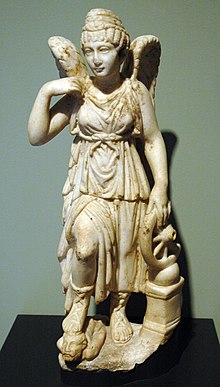Nemesis
In ancient Greek religion, Nemesis (Ancient Greek: Νέμεσις), is the goddess who takes vengeance against those who show hubris (arrogance before the gods).

Divine retribution is a major theme in the Hellenic world view. It is the unifying theme of the tragedies of Sophocles and many other literary works.[1][2]
She carried a measuring rod (a tally stick), a bridle, scales, a sword, and a scourge (whip), and she rides in a chariot drawn by griffins.
Nemesis often is seen with another goddess named Aidos. Aidos is the goddess of shame. She is similar to Nemesis.[3]
The Ancient Greek made different meanings for what they called "justice":
- Nemesis (as a goddess who gives to each what they deserve)
- Dike (to be in charge of what we would call civil law today)
- Dikaiosyne ("a just state," where the word justice comes from, meaning that everything is fair in their country)
- Nomos (a law made by the government)
In works of fiction the hero's nemesis is usually the villain and the hardest antagonist for the hero to defeat.
References
change- ↑ Sanders, Karin. "Nemesis of Mimesis: The Problem of Representation in H. Andersen's "Psychen"." Scandinavian Studies 64, no. 1 (1992): 1-25. http://www.jstor.org/stable/40919385.
- ↑ Examples of Nemesis in Literature, 19 August 2013, retrieved October 12, 2013
- ↑ Homer, Illiad, 13,121f
Other websites
changeMedia related to Nemesis at Wikimedia Commons